
The Blackface or Scottish Blackface is a British breed of sheep. It is the most common sheep breed of the United Kingdom. Despite the name, it did not originate in Scotland, but south of the border.

The Cotswold is a British breed of domestic sheep. It originates in, and is named for, the Cotswold hills of the southern midlands of England. It is a large long-woollen sheep, and is kept as a dual-purpose breed, providing both meat and wool.

The Suffolk is a British breed of domestic sheep. It originated in the late eighteenth century in the area of Bury St. Edmunds in Suffolk, as a result of cross-breeding when Norfolk Horn ewes were put to improved Southdown rams. It is a polled, black-faced breed, and is raised primarily for its meat. It has been exported to many countries, and is among the most numerous breeds of sheep worldwide.

The Lonk is a British breed of domestic sheep. It belongs to the group of black-faced hill breeds of northern England, and is found in the hills of the central and southern Pennines of Lancashire and Yorkshire. It is documented from the mid-eighteenth century; a flock book was started in 1905.

The Oxford Down is a British breed of domestic sheep. It was developed in the 1830s by cross-breeding of Hampshire Down and Southdown ewes with Cotswold rams. It is reared primarily for meat.
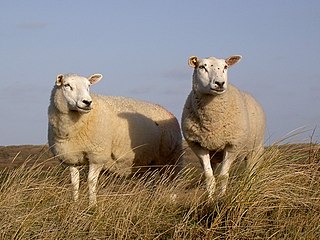
The Texel is a Dutch breed of domestic sheep originally from the island of Texel. It is a heavy and muscular sheep, and produces a lean meat carcass. It is polled, clean-faced and clean-legged, with white face and wool. The fibre diameter of the wool averages about 32 μ, with a staple length of 8–15 cm; it is used mainly for knitting and hosiery wools.
The Easycare or Easy Care is a modern British breed of easy-care sheep. It was developed in Wales in the second half of the twentieth century by cross-breeding between Welsh Mountain and Wiltshire Horn stock, with the aim of combining the meat-producing qualities and natural moulting characteristic of the latter with the hardiness of the former. It is reared for meat production.

The Fries Melkschaap is a Dutch and German breed of dairy sheep. It originates in the Frisia region, which includes parts of both northern Holland and north-western Germany. It has many names: the German stock is known as the Ostfriesisches Milchschaf, or in English as the East Friesian, the East Friesland Milch or the German Milksheep, while the Dutch equivalent is known as the Friesian Milk or Friesian Milksheep, or less often as the Friesian or West Friesian. Under suitable management conditions, it is among the highest-yielding of dairy sheep breeds.
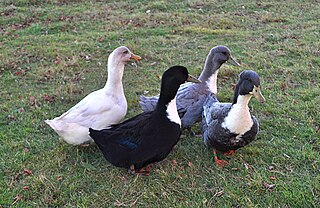
The Swedish Blue or Blue Swedish is a Swedish breed of domestic duck. It originated in the former dominion of Swedish Pomerania – now in north-west Poland and north-east Germany – and is documented there from 1835. It is closely similar to the Pomeranian Duck from the same general area, differing mainly in its white primary feathers.

The Dorset Horn is an endangered British breed of domestic sheep. It is documented from the seventeenth century, and is highly prolific, sometimes producing two lambing seasons per year. Among British sheep, it is the only breed capable of breeding throughout the winter.
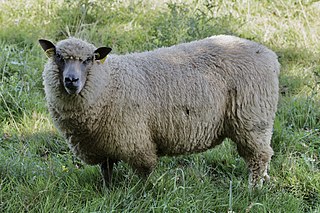
The Bleu du Maine is a French breed of domestic sheep. It originated in the historic region of Maine, and is distributed mainly in the départements of Maine-et-Loire, the Mayenne and the Sarthe in the Pays de la Loire in western France.

The Castlemilk Moorit is a rare breed of domestic sheep originating in Dumfriesshire in Scotland.
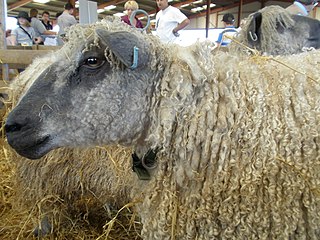
The Wensleydale is a British breed of domestic sheep. It is named for the Wensleydale region of North Yorkshire, in the north of England, where it was bred in the early nineteenth century by cross-breeding a Dishley Leicester ram with local long-woolled sheep of a breed that is now extinct. It has a blue-grey face and long purled wool, and is among the heaviest of British sheep breeds. It is an endangered breed, and is categorised as "at risk" by the Rare Breeds Survival Trust. It is often used as a ram breed to cross with other breeds to obtain market lambs, and for its high-quality wool.
The Devon Closewool is a British breed of domestic sheep. It is distributed almost exclusively on Exmoor in North Devon, in south-west England. It is raised primarily for meat.
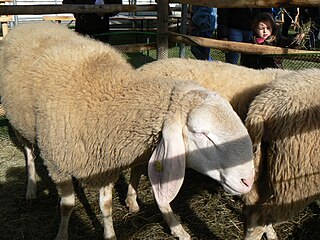
The Bergamasca is a breed of domestic sheep from the mountainous part of the province of Bergamo, in Lombardy in northern Italy. It originates from the area of the Val Brembana and the Val Seriana valleys, and is particularly associated with the plateau of Clusone. By the beginning of the 20th century it had spread through much of Lombardy; it is now raised in most parts of mainland Italy, particularly the province of Teramo in Abruzzo, where more than 80% of the registered stock are kept. The Bergamasca is also present in Brazil, Serbia and Venezuela. It is raised principally for meat, and is often used for cross-breeding with other meat breeds to improve meat yield. In Lombardy, it is traditionally raised by transhumant management: the herds spend the summers on the alpine pasture, and over-winter in the Po valley.

The Charmoise is a French breed of domestic sheep. It was created in the early nineteenth century by Édouard Malingié, by cross-breeding of Romney stock imported from the United Kingdom with local breeds including the Berrichon du Cher, Merino, Solognote and Tourangelle. It is reared for both meat and wool. Breed numbers fell from a peak of approximately 650000 in the 1960s to about 122000 in 1983, to approximately 21000 in 2001, and further to 8100 in 2014.

The Devon Longwool was a British breed of domestic sheep from south-west England. It was distributed in southern Somerset and northern Devon, and was – like the Greyface Dartmoor and the South Devon – a polled longwool sheep. It is now considered extinct, as in 1977 it was merged with the South Devon to form the Devon and Cornwall Longwool.
The Brentegana is an Italian breed of sheep from the provinces of Trento and Verona in northern Italy. The name derives from that of the comune of Brentonico, the area where the breed is thought to have originated. Two distinct types are known: the Brentegana Scelta or Brentegana Trentina, a large heavy meat/wool type; and the Brentegana Comune, a medium-sized type more suitable for milk production. It is one of the forty-two autochthonous local sheep breeds of limited distribution for which a herdbook is kept by the Associazione Nazionale della Pastorizia, the Italian national association of sheep-breeders.

The Australian Merino is an Australian breed or group of breeds of sheep, forming a significant part of the Merino group of breeds. Its origins lie in Merino sheep imported to Australia from South Africa in about 1796. By about 1830 there were almost two million Merinos in the country.

















